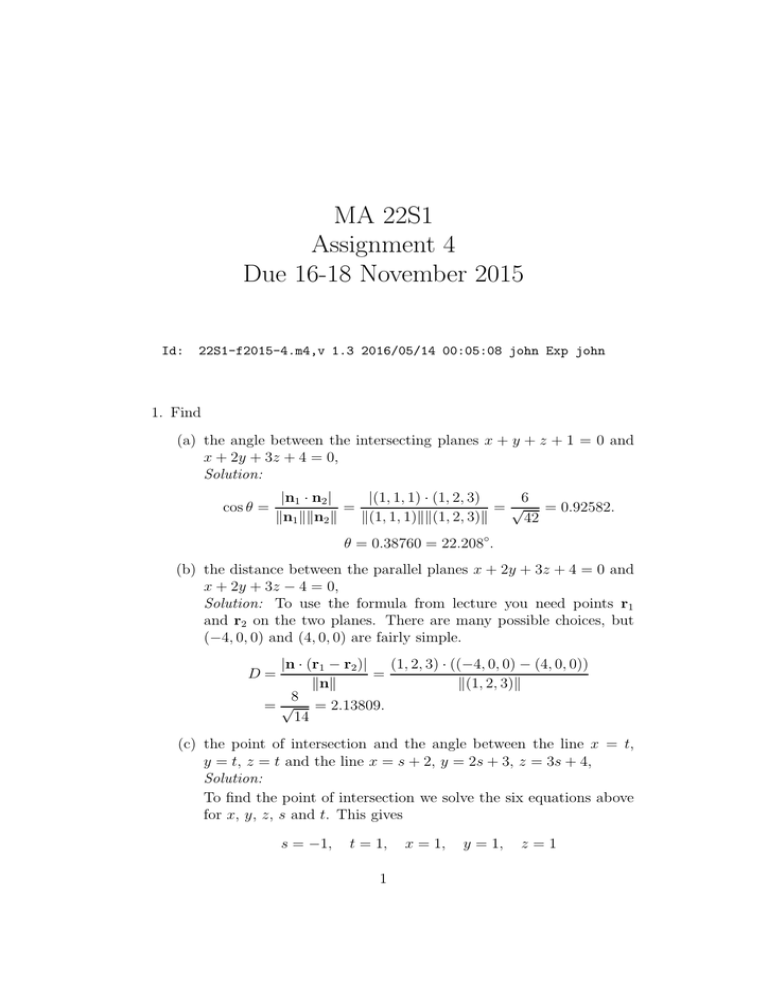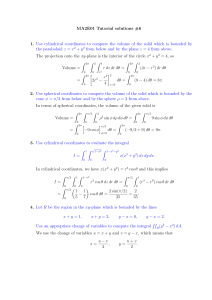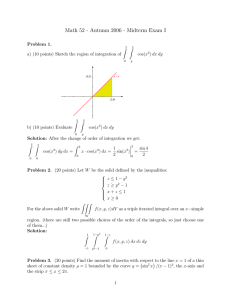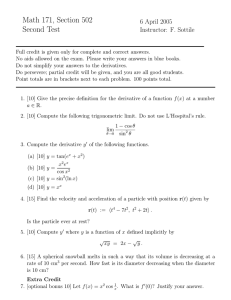MA 22S1 Assignment 4 Due 16-18 November 2015
advertisement

MA 22S1 Assignment 4 Due 16-18 November 2015 Id: 22S1-f2015-4.m4,v 1.3 2016/05/14 00:05:08 john Exp john 1. Find (a) the angle between the intersecting planes x + y + z + 1 = 0 and x + 2y + 3z + 4 = 0, Solution: cos θ = |n1 · n2 | |(1, 1, 1) · (1, 2, 3) 6 = = √ = 0.92582. kn1 kkn2 k k(1, 1, 1)kk(1, 2, 3)k 42 θ = 0.38760 = 22.208◦. (b) the distance between the parallel planes x + 2y + 3z + 4 = 0 and x + 2y + 3z − 4 = 0, Solution: To use the formula from lecture you need points r1 and r2 on the two planes. There are many possible choices, but (−4, 0, 0) and (4, 0, 0) are fairly simple. |n · (r1 − r2 )| (1, 2, 3) · ((−4, 0, 0) − (4, 0, 0)) = knk k(1, 2, 3)k 8 = √ = 2.13809. 14 D= (c) the point of intersection and the angle between the line x = t, y = t, z = t and the line x = s + 2, y = 2s + 3, z = 3s + 4, Solution: To find the point of intersection we solve the six equations above for x, y, z, s and t. This gives s = −1, t = 1, 1 x = 1, y = 1, z=1 Id: 22S1-f2015-4.m4,v 1.3 2016/05/14 00:05:08 john Exp john 2 so the intersection is (1, 1, 1). For the angle, cos θ = |v1 · v2 | |(1, 1, 1) · (1, 2, 3) 6 = = √ = 0.92582. kv1 kkv2 k k(1, 1, 1)kk(1, 2, 3)k 42 θ = 0.38760 = 22.208◦. (d) the distance between the skew lines x = t, y = t, z = t and x = s + 2, y = 2s + 3, z = 3s − 4, Solution: D= 8 |(r1 − r2 ) · (v1 × v2 )| = √ = 3.26599. kv1 × v2 k 6 (e) the distance between the parallel lines x = t, y = t, z = t + 1 and x = s, y = s, z = s − 1. Solution: √ 5 k(r1 − r2 ) × vk D= = √ = 1.29099. kvk 3 2. Each of the following surfaces is given in one of Cartesian, cylindrical or spherical coordinates. Convert it to the other two. Simplify as much as possible. (a) x2 − y 2 + z 2 = 0, Solution: In cylindrical coordinates r 2 cos2 θ − r 2 sin2 θ + z 2 = 0 or r 2 cos(2θ) + z 2 = 0. In spherical coordinates ρ2 sin2 φ cos(2θ) + ρ2 cos2 φ = 0 or cos(2θ) + cot2 φ = 0. (b) ρ = cot φ csc φ, Solution: Multiplying by ρ sin2 φ, ρ cos φ = ρ2 sin2 φ Id: 22S1-f2015-4.m4,v 1.3 2016/05/14 00:05:08 john Exp john 3 or, in cylindrical coordinates, z = r2 . In Cartesian coordinates z = x2 + y 2. (c) r 2 − 2rz cos θ + z 2 = 1, Solution: In Cartesian coordinates x2 + y 2 + z 2 − 2xz = 1. In spherical coordinates ρ2 − 2ρ2 cos θ sin φ cos φ = 1 or ρ2 (1 − cos θ sin(2φ)) = 1.





